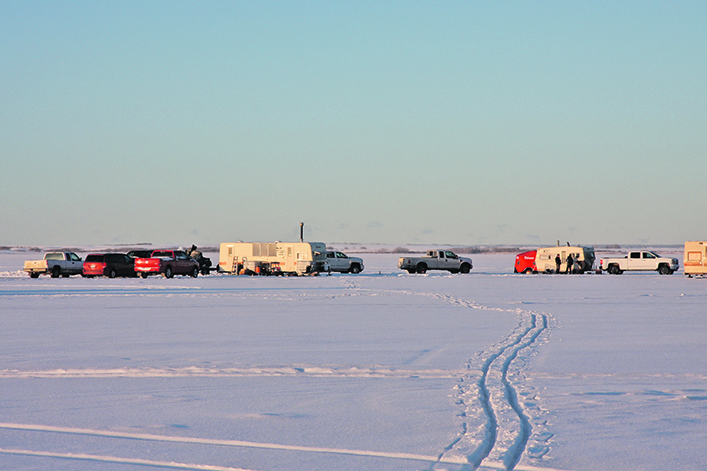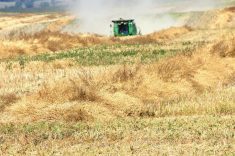Agriculture played a major role in the community, but its location on Jackfish Lake also kept villagers’ eyes on the water
The village of Meota, Sask., is situated on the southern shores of Jackfish Lake about 43 kilometres northwest of North Battleford.
The community derived its name from the Cree words Meotate or Mo-Was-In-Ota, meaning “good place to camp” or “it is good here.”
One of the earliest European visitors to the Meota region was Dr. James Hector of the Palliser expedition on Dec. 17, 1857. He noted in his journal that agriculture could flourish in the area. By 1894, most of the land in the area had been surveyed and by 1900, the greatest influx of settlers took place.
The homesteaders were a diverse group including Metis, French, English, Scottish, Irish, Scandinavian, and people from other parts of Europe.
In 1893, Napoleon Venne made one of the first land claims in the area. It was a good year for growing crops but a big drought followed along with prairie fires. As a result, Venne abandoned his homestead and headed to the Klondike in search of gold. It wasn’t until 1902 that his homestead became occupied again with the influx of more homesteaders.
The first post office in Meota was established in 1910, but it was initially called Beachview.
Joseph A. Dart, an early merchant, established a store in a tent near Meota, and in 1910, he moved to the Meota townsite where his store operated in a building on main street. The Canadian Northern Railway opened its line through Meota in 1910-11, followed by the construction of the first grain elevator.
Meota incorporated in 1911 and the village had two hotels, a butcher shop, a drug store, two general stores, a blacksmith shop, a livery barn, gun shop and post office, lumber yard, a doctor and a nurse, as well as various kinds of tradespeople.
Other industries followed included brick manufacturing, a flour mill, and commercial fishing for white fish known as Meota Whites.

However, a series of fires decimated the village’s business district, and with the coming of the automobile many local residents drove to North Battleford for shopping.
Being on the shores of Jackfish Lake, Meota enjoyed prosperity due to summer vacationers coming to the lake. With the influx of all the summer vacationers, the Meota Board of Trade in 1912 presented plans for Meota to become the Newport or Coney Island of Saskatchewan. They envisaged a floating ballroom on the beach where couples could dance the latest dances imported from New York.
The Canadian Northern Railway began making trips to bring people from North Battleford to Meota to spend the weekend. The train would leave North Battleford on Saturday morning and return on Monday.
A thousand people came to a picnic on the beach in 1915 and 600 of them were public schoolchildren sponsored by the school board of North Battleford.
Finally in 1921, the Board of Trade got part of its original wish when the Walker brothers, who were also musicians, and their partner, Bob Davis, built and opened a dance pavilion on the lake front.
The pavilion featured an area for dancing, and in later years an ice cream parlor and lunch bar were added complete with a mirror that ran the full length of the bar.
Wooden shutters around the outside walls could be opened during the summertime. The nightly dancing music coming from the pavilion added a carnival-like atmosphere to the beach, almost making Meota the Coney Island of Saskatchewan.
Unfortunately, the landmark was destroyed by fire in July 1963.
Jackfish Lake has always been important to fishermen. As far back as 1892 the early settlers were catching and selling fish. In the winter of 1925-26 a fresh fish market was established and commercial fishing became big business. As the fishing industry grew over the years, the start of the winter ice-fishing season was around Dec 1. Nets were used to catch whitefish and quotas and licensing were required.

Local farmer Walter Tait remembers as a boy helping to pack the fish on ice in 50-pound boxes in the 1940s. The fish were then taken to Saskatoon and flown to New York and sold as Meota Whites. In later years, the community shipped refrigerated railway cars full of Meota Whites to New York.
To catch the whitefish, nets from 85 to100 metres and a jigger were used to get the nets under the ice from one hole to the next. This greatly improved the fishermen’s success.
On opening day, the fishermen in their horse-drawn cabooses lined up on the shore and at the signal from a gun they all raced to their favorite fishing spot out on the lake. Some fishing nets could yield as many as a hundred fish and other nets yielded less and maybe none.
Tait remembers one year that the fish catch was so great that the fish were laid out on the main street in Meota to freeze because there wasn’t room in the fish processing area to handle all of them.
In the 1950s a fish co-op was formed and the fish were sold through the fish board. Before the formation of the fish board, buyers from New York and elsewhere were on-hand to bid on the fish and one year the price started at eight cents a pound and two days later it was running at 18 cents a lb.

Besides fishing, agriculture was important to the area around Meota. Tait’s grandfather, a shepherd near Edinburgh, Scotland, started a new life farming at Meota in the autumn of 1903. In those early days land was cultivated using a Rumley steam engine tractor pulling an eight-bottom plow.
Tait remembers when his grandfather’s farm was chosen as an experimental farm to demonstrate new and improved agricultural practices to farmers in the area.
He recalls the excitement of agricultural field days on his grandfather’s farm. A large tent was erected where the local farmers could meet and listen to various Agriculture Canada researchers on the latest information on crops and livestock production.
Today, most of those early businesses are gone, as are the railways and grain elevators. Farming is still a big part of the community and recreational ice fishing is still prevalent on the lake. Every winter the locals wait for the ice to get thick enough so that they can get out on the ice and enjoy their favorite winter pastime.















